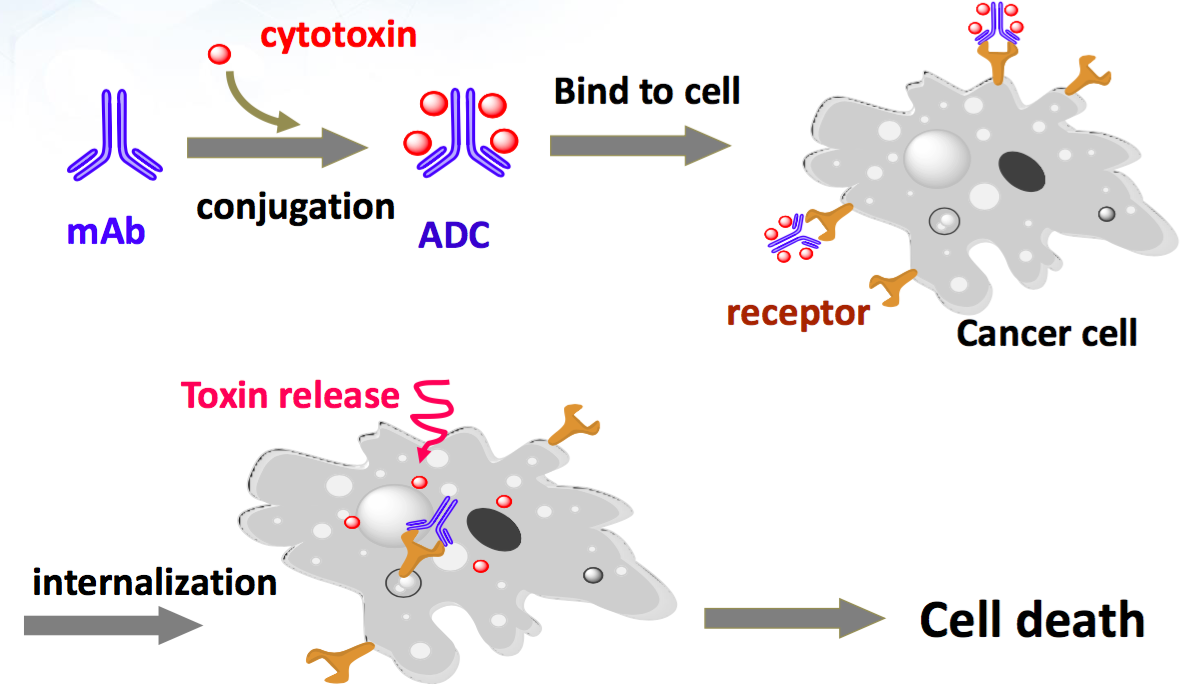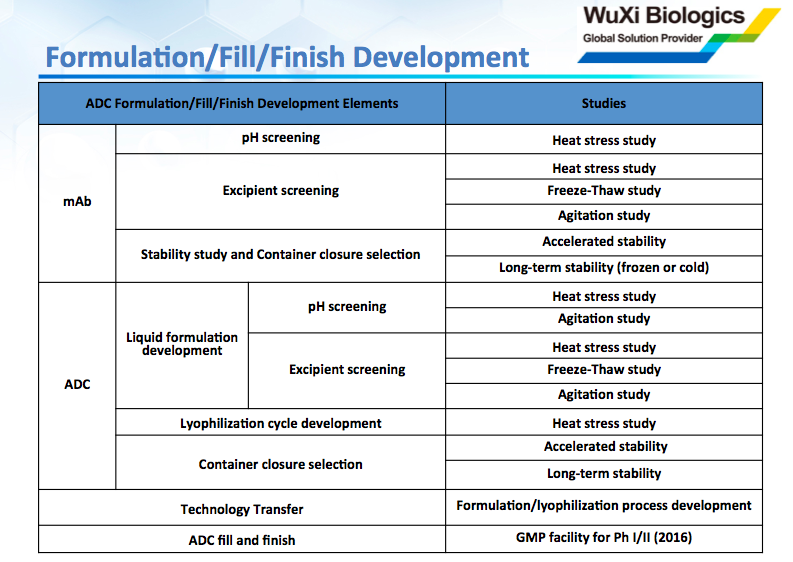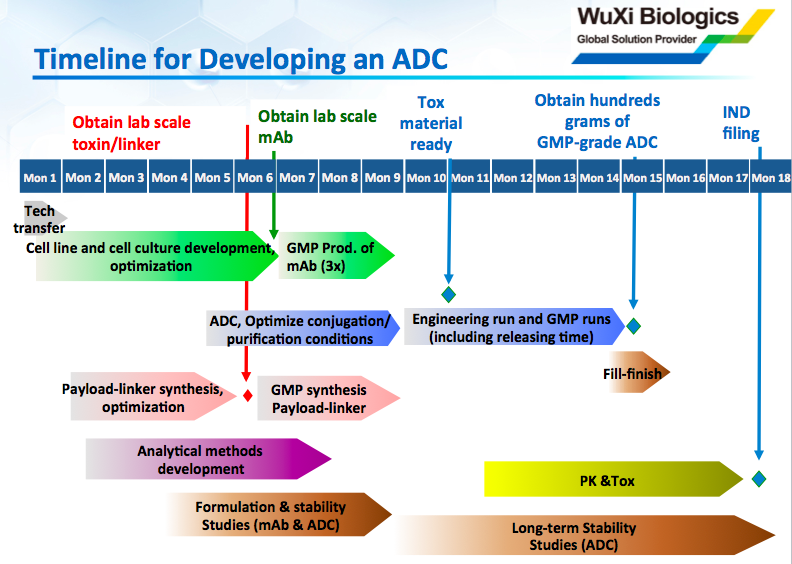
Antibody Drug Conjugates – An Overview of the Technology and Manufacturing
Antibody drug conjugates offer tremendous therapeutic potential, but they also present both technological and manufacturing challenges. With two ADCs currently on the US market and many more in clinical development, the market for ADCs is expected to expand rapidly.
Antibody Drug Conjugate Technology
Antibody drug conjugates are composed of three parts:an antibody specific for the tumor associated antigen, which has restricted expression on normal cells, a cytotoxic agent designed to kill target cells when internalized and released and, a chemical linker to attach the cytotoxic agent to the antibody. New linker systems are designed to be stable in circulation and release the cytotoxic agent after being internalized by the targeted cells. Because the cytotoxic agent is delivered in such small quantity, it must be powerful enough to kill the tumor cells. Therefore, the potency of these cytotoxic agents is 100-1000 fold more potent than cytotoxic agents delivered as free drugs. The real benefit is the ability to deliver a very potent cytotoxic agent only to the targeted tumor cells.
Figure 1: ADC Concept

In exploring this topic in more detail, I found a very interesting webinar that provided an overview of both the evolution of ADCs as a technology and also the manufacturing challenges associated with their production. The webinar, “Strategies for ADC Development,” was presented by Dr. Jiawen Han, Vice President of ADC Technology, WuXi Biologics and Dr. Jun Wang, Executive Director of ADC Technology, WuXi Biologics.
Evolution of Antibody Drug Conjugate Technology
The webinar began with a discussion of the early stage ADCs that were being developed from 1980-1990. While the concept of linking an antibody with a cytotoxic agent was sound, there were several flaws that made this first generation of ADCs unsuccessful. For one, they employed standard anti-cancer drugs such as doxorubicin, vinblastine, and methotrexate, which were not potent enough in such small quantity to kill the tumor cells. There was also poor localization of the antibody to the tumor and thus insufficient delivery of the cytotoxic agent into the tumor cell. In some cases, the linker used was not stable in circulation and created an immunogenicity issue, which led to a limited dosing range.
The results of these initial preclinical and clinical data for early ADCs were that they only improved the efficacy of the cytotoxic agent (payload) by a factor of 2-3 in some cases. They were typically less potent than free drug administration in vitro and usually displayed no increased anti-tumor activity over the free drug. It was clear that higher potency payloads and non-immunogenic antibodies were needed.
The talk went on to describe how from 1990-present, ADC technology has made significant advancements that resulted in effective, commercially viable therapies. The primary improvements were to use more potent cytotoxic agents as payloads and to use humanized or fully human antibodies that were non-immunogenic.
There have been three ADCs approved by the FDA, Mylotarg (Pfizer/Wyeth) was approved in 2000 for treatment of acute myeloid leukemia, but was voluntarily withdrawn from the market in 2010. Adcetris (Seattle Genetics) was approved in 2011 for treatment of Hodgkin lymphoma and anaplastic large cell lymphoma. Kadcyla (Genentech/Roche/Immunogen) was approved in 2013 for treatment of HER2 positive late stage breast cancer. There are currently over 40 ADCs in various stages of clinical development.
Challenges in Antibody Drug Conjugate Technology
Despite the advancements from early ADC attempts, there were still several challenges.
Primarily:
- Lack of truly targeting antibodies
- Limited choices of highly effective linkers and conjugation methods
- Only a few classes of highly potent cytotoxic agents
Many challenges were overcome in large part with success in new conjugation methods including:
- THIOMAB technology (Genentech/Roche)
- Non-amino acid based site specific
- Enzyme assisted site specific
- Engineered sugar-based site specific
These site specific conjugations have provided significant improvements,as there are several drawbacks to the traditional conjugation methodologies. With traditional conjugation you can have many cysteine and lysine residues in the antibody molecules thusobtaining a heterogeneous mixture of ADC molecules with distinct affinities, stabilities, pharmacokinetics and safety profiles. This effect also causes difficulties in developing consistent manufacturing and QC. With site specific conjugation these drawbacks are greatly reduced and site specific conjugation facilitates synthesis, purification analysis, establishing release criteria and simplifies pharmacokinetic profiles as well.
Additionally there has been the development of new cytotoxic agents that offer better options, these include (but not limited too):
- PBD
- Amanitins
- SN 38
- Dual active payloads
In order to have an effective ADC, you need all three component parts to work properly.
For instance the chemical linker must be:
- Stable in storage
- Stable in circulation
The antibody must have:
- High tumor specificity
- High avidity (KD ~0.1nM)
- No immunogenicity
The Cytotoxin must be:
- Linkable
- Water soluble
- High potency (IC5001~0.1nM)
- Stable in antibody form
Antibody drug conjugate manufacturing
As the success of ADCs grew in preclinical and clinical studies, the manufacturing methods had to evolve to improve the commercial manufacturing for these products. The increased potency for the cytotoxic agents created a safety problem for those who were working to manufacture the ADC. This high level of toxicity means that there had to be significant primary and secondary containment strategies in place.
As a result of these stringent safety containment measures, many pharmaceutical companies have opted to outsource the manufacturing of their ADCs to Contract Manufacturing Organizations (CMOs). A recent report titled, “ADC Contract Manufacturing Market (2nd edition), 2015-2025,” by Roots Analysis estimates that approximately 70% of all ADC manufacturing is outsourced to CMOs. According to the report there are 20 CMOs that have the capability of producing both the cytotoxic agent and provide the conjugation services and 15 also provide finish/fill. WuXi is one of the CMOs that provides complete manufacturing of ADCs from start to finish. During the webinar, WuXi discussed the various aspects of ADC manufacturing including specific steps and studies required (Figure 2). They also provided their timeline for ADC development from tech transfer to IND filing (Figure 3).
Figure 2:

Figure 3:

Antibody Drug Conjugate Market
The Roots Analysis Report, “ADC Contract Manufacturing Market (2nd edition), 2015-2025,” also provides information about the ADC market. Report highlights related to the market for ADCsincluded:
- The report publisher expects Adcetris and Kadcyla, the two commercially available ADCs, to start generating annual sales of close to USD 1 billion in the near future. In addition to the marketed molecules, there are over 40 candidates in clinical development; of these, 25% are in Phase II & III.
- Seattle Genetics and Roche, with 7 and 6 molecules in clinical development respectively, currently have the most developed portfolio of ADC molecules. Relatively new entrants include (indicative list, in alphabetical order) AbGenomics, Abzena, Affinicon, Allozyne, Endo Pharmaceuticals, Formation Biologics, Intellect Neurosciences, Kairos Therapeutics, Menarini Biotech, Mersana Therapeutics, Oxford BioTherapeutics, Philochem, Synthon and Zymeworks; emergence of these firms is likely to provide the necessary push, both in terms of technology and innovation.
- In the base scenario, we anticipate the overall CMO market for ADC manufacturing to breach the USD 1 billion mark in the coming decade. In fact, there is a strong belief in the market that existing CMO facilities for ADC manufacturing will require expansion to cater to the growing population of pipeline molecules.
For more information, please see:
Strategies for ADC Development
ADC Contract Manufacturing Market (2nd edition)